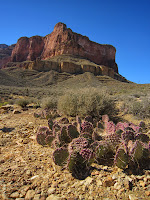We spent the first week of November in Glendale, Arizona with my sister and her family. I had been to Arizona before long ago, but memories blur and fade with time and it seemed as new an experience for me as it was for Sam.
 |
| A View of the Indian Gardens from the Trail |
In this regard, we were fortunate to have the cool fall temperatures and a well stocked backpack of supplies with each of us. With the dangers of the summer heat behind us, we would not have to face one of the most potent pitfalls that the canyon brings.
 |
| A View of the Colorado at Plateau Point |
The Grand Canyon is one of the few places on earth that evoke a surreal quality. Sam described the towering walls of the North Rim as akin to a fresco, painted by the hands of an artist as opposed to a millennial process of the Colorado leaving its mark in the sandstone.
The Bright Angel Trail includes two rest houses at Mile 1.5 and Mile 3. Further on the descent, the trail bisects the Indian Gardens, a bloom of trees and vegetation, among the arid desert soils that is fed by a small stream.
We started early in the morning at 8 am. Just like the day before, the low sun in the sky at the start the descent cast long shadows and painted contrast into the cliff walls.
I read somewhere that most photographers, especially outdoor photographers, prefer to take pictures during the early morning or late evening because the sunlight is not so harsh during these hours. The noon sun overhead can wash out colours whereas the morning and evening sun bring them out. Walking down the trail a half hour after sunrise, it was not hard to understand why.
From the Indian Gardens, you can take a path that heads roughly north out to Plateau Point where you get your first (and for us, the last) view of the Colorado River. For all the grandeur of the canyon, sometimes it is difficult to remember that it was cut mostly by the mighty Colorado River, a river that requires a 4 hour hike just to get a view of.
I realise that I am fortunate to be able to do these things. Being outside, amongst one of the grandest of spectacles is not something everyone takes or gets the opportunity to do.
The draw with these hikes is that these kinds of things never get old. You could spend a life time in here and still be learning new things every day. It lends perspective. It might have taken 17 million years to get the vista that unrolls like gigantic scroll east and west before me. My life, long or short, is comparatively brief. A setting like this is a reminder that we, as human beings, have a spectacular opportunity to contribute and to do great things. The window is brief, but if you so choose, you can be a part of something big.
We took three and a half hours to get to Plateau Point. Surprisingly, our return trip would be only four a half hours.
 |
| The Return Trip |
















